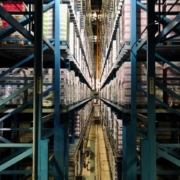Efficient supply chain with Big Data.
In recent decades, companies have applied technology, outsourcing and lean to reduce their costs. Now is the time to realize an Efficient supply chain with Big Data
The savings due to technology and certainly outsourcing are slowly decreasing. The low hanging fruit has been picked by most companies. Cost differences between Asia, Europe and the United States have also decreased significantly in recent years.
On the other hand, the complexity of supply chains has increased significantly in recent years. From a few suppliers to sometimes 6 and 7 tiers. Consumer demand has also become more complex and demanding. In particular, predictability has decreased drastically.
The combination of large quantities of goods that need to be distributed quickly around the world in the shortest possible time span is the next challenge for supply chains. To be able to make the right choices, set priorities and gain and maintain a competitive advantage in this context, insight into flows and especially customer demand is essential.
Visualization.
With the advent of Big data technology, other information technology has also increased significantly. Visualization techniques have always been in the spotlight because a human can interpret images better and faster than large amounts of text or data. Current technology offers the possibility to place your entire supply chain, worldwide, in a visual context, including volumes and values. This gives supply chain executives the opportunity to quickly understand where the potential improvement potential lies.
This can be done, for example, by evaluating the different distribution lanes, warehouses and cross dock points at European level. Visualization quickly shows you if there is too much overlap or if there are clear gaps in your distribution model. At the urban level it is possible to compare the different delivery routes and avoid unnecessary laps.
Future question.
The available data offers organizations the opportunity to map the many factors that influence demand and to search for correlations and causal connections. By making good analyzes, drawing up algorithms, the demand becomes more predictable and insight into the drivers of the consumer is obtained. This will only work if the different sources of information can be combined from the different systems. It is not without reason that more and more software developer Cloud offers possibilities to merge the different flows of information. Companies that succeed in this turn out to quickly realize a 20% stock reduction and improve their fill rate by 3-7 percentage points.
Simplify your supply chain.
It’s an open door. Keep things simple. But in a complex rapidly changing world, that is still quite a challenge. Often people do not dare to cut the historically grown network of transport, warehousing, production facilities and distribution networks. The unbridled growth of such a network increases your costs progressively, while the quality and service of your supply chain is under pressure, because there are simply too many drives at stake.
Big data together with visualization techniques can provide insight into the most important bottlenecks in your supply chain. With the techniques and analysis options now available, the revision of networks can be realized a lot faster than before. In doing so, your network is directly tailored to market demand.
The four steps to efficiency
Transparency.
Providing full insight into your supply chain and information exchange across the chain remains one of the most important conditions. Only if you can actually monitor your flow of goods will you be able to take full advantage of Big Data. Start with some important flows where you can learn important lessons about your supply chain.
Data consistency.
Data doesn’t have to be perfect. It never will be. What is important is that the data, even if it is not 100% reliable, is consistent in its unreliability. You can still work fine with a certain degree of unreliability. In addition, you can work on simplifying your data, and thereby increasing reliability, by reducing the number of SKUs, decreasing or stabilizing lot sizes in size and using the same unit of measure throughout the chain. This prevents conversion and interpretation errors.
Data exchange.
Provide cross functional data exchange possibilities. The continuous conversion of data so that it is understandable for the next link contributes to loss of reliability, the speed of processing decreases, which ultimately has an effect on the performance of your supply chain. Also, the lack of a good data exchange option is often an obstacle to providing an optimal service to your customers, because the service desk cannot trust or is unable to convert the supplied data into useful information for the customer.
Competencies.
Tomorrow’s supply chain will demand completely different competencies. But hiring only top analysts is not the solution either. Ultimately, the information obtained from Big Data must be converted into usable operational data, while the operational teams also understand the benefits they can achieve with this. Cross functional teams at Sales & Operational planning level is a step in the right direction.
Companies that successfully convert the above recommendations into operational policies will ultimately have an unprecedented advantage over other organizations.









